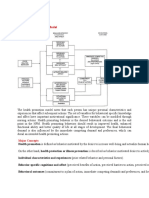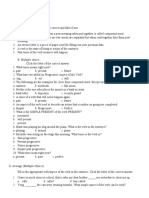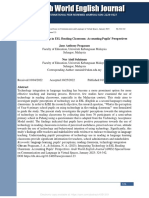Case-Studies Chapter 6
Case-Studies Chapter 6
Uploaded by
Alyssa Mariae CodornizCopyright:
Available Formats
Case-Studies Chapter 6
Case-Studies Chapter 6
Uploaded by
Alyssa Mariae CodornizCopyright
Available Formats
Share this document
Did you find this document useful?
Is this content inappropriate?
Copyright:
Available Formats
Case-Studies Chapter 6
Case-Studies Chapter 6
Uploaded by
Alyssa Mariae CodornizCopyright:
Available Formats
Title: Mental Exercise
Name: DONNA F GARCIA Subject: Health Ed P&P Date: April 23, 2022
Case Study
(Chapter 6: Compliance, Motivation, and Health Behaviors of the Learners)
“Keeping our employees healthy is not only the right thing to do, it is good for the bottom
line.” With this directive from the chief executive officer, Marie DeSantis, the staff in the Office
of Human Resources at Jefferson Pharmaceuticals developed a “Let’s Get Healthy” initiative for
its 500 employees. Weight Watchers, a smoking cessation program, and yoga classes were
brought on site and offered free of charge to all employees. Nicotine patches were offered at
50% of cost and gym memberships were provided at a significant reduction in price. The
cafeteria began offering healthy low-calorie meals and a walking club was started to support staff
who chose to exercise before and after work or during lunch hours. Staff who were willing to
submit an individual health plan and agreed to participate in one or more of the company’s
available health programs were offered a 10% discount in their health premiums.
One year after the start of Let’s Get Healthy, the initiative is in trouble. Although initially
met with a great deal of enthusiasm, staff compliance has declined. Attendance at Weight
Watchers and smoking cessation classes is episodic and yoga classes were cancelled because of
lack of interest. Anecdotal information suggests that although the company has renewed gym
memberships for about 20% of the staff, few are actually using them on a regular basis.
Convinced that Let’s Get Healthy is a good idea, the company has hired a health educator to
evaluate the program and make recommendations for improvement.
1. Using one of the identified models and theories of compliance (health belief model, self-
efficacy theory, protection motivation theory, stages of change model, theory of reasoned
action, or therapeutic alliance model), provide a possible explanation for why the staff
members at Jefferson Pharmaceuticals are not participating in the Let’s Get Healthy
campaign.
A health regimen's compliance is an observable, directly measurable behavior. In
contrast, motivation is an indirectly measurable precursor to action through behavioral
consequences or outcomes. Adherence is a long-term commitment or attachment to a
regimen.
Making healthy lifestyle changes is difficult to comply with because positive outcomes
from behavioral change are rarely immediate, leading to frustration and non-adherence to
health plans that focus on long-term benefits rather than immediate gratification. In order to
aid patient compliance, a social cognitive theories' web-based behavior motivational tool was
developed. By creating scenarios and "information interventions based on predefined rules to
achieve effective compliance," entertaining gaming techniques encourage behavior change
(Lin, Ramakrishnan, Chang, Spraragen, & Zhy, 2013, p. 58).
"Let's Get Healthy" may have increased the perceived value of exercise for weight loss
and health (as a preventive or treatment "medicine" while inadvertently reducing the
experiential benefits of exercise, such as social interaction, expression of personal skills, and
abilities, self-development, or pure enjoyment. In a recent review of physical activity,
behavioral change mediators and the experiential qualities of exercise were considered
critical adherence factors. On that note, it's probably no coincidence that physical activities
not traditionally associated with the term "exercise," such as sports, dancing, and outdoor
exploration activities, are rarely mentioned in the current public health dialogue about
"exercise as medicine." If such beneficial activities are not highlighted, it could hinder public
health and exercise promotion.
2. What motivational strategies did the human resources staff use in Let’s Get Healthy? Why do
you think these strategies did not work?
Poor exercise adherence or completely giving up on a fitness goal is often based on
physiological and psychological factors that limit success. This is one of the most common
mistakes. Setting an unrealistic goal is the easiest way to pave the road for discouragement.
Physiological and psychological factors that limit success are often the cause of poor
exercise adherence or complete abandonment of a fitness goal. It's one of the most common
blunders people make. Setting an improbable goal is the quickest way to set yourself up for
disappointment.
Others do not believe it is a worthwhile endeavor. Their exercise behavior is also not
self-determined because it is governed by external factors. They are exercising because they
have been told by a higher authority, even if they do not believe it is necessary. People may
be motivated to comply with external pressure to act when regulated in this way, but they do
so unwillingly, even resentfully, and are unlikely to continue if the external pressure is
relaxed.
There are many different motivating factors that drive people to make behavior change
for both weight loss and smoking. Programs that can provide a personalized, holistic
approach and that can connect that individual to the tools and resources they specifically
need to overcome barriers can be beneficial in supporting behavior change. Readiness to
change and the decision to finally make a commitment seem to be the top motivating factors
across both weight loss and smoking cessation. Employers should ensure they consistently
communicate the availability of these programs to ensure they are top-of-mind when
employees are finally ready for behavior change. Employers should view behavior change as
a longer-term process. Most who are successful at weight loss or smoking cessation have
made numerous prior attempts. Organizations should look at both short- and long-term
metrics in their program assessments. While there are commonalities between successful
smoking cessation and weight loss, there are clear differences as well. Communications
should focus on the unique motivators and benefits to ensure the most relevant and
compelling messaging possible.
3. Do you think that if a health education campaign was offered in conjunction with the Let’s
Get Healthy program, the results would have been different?
Yes, there is a need for education in conjunction with the Let’s Get Healthy program to
address the lack of information on benefits of healthy diet as well as the benefits of exercise
and how exercise should be undertaken. Level of non-adherence is high whether it is lifestyle
recommendation or treatment prescription. Numerous factors are responsible for non-
adherence, and for each type of recommendation, factors are different. A health professional
should consider all possible factors which hinders adherence of the patients to the diet,
physical activity, and treatment regimen while guiding the patients.
The culture of health in supporting behavior change and motivating individuals is
significant in achieving and sustaining lifestyle improvement. It must comprise a broader
view of program and service composition, combining a wide range of resources, activities,
and communication channels to envelop consumers in a web of positive influence that helps
us identify the individuals who are ready to change and proactively engage them when they
are most receptive to support. By engaging when employees are ready to change, we can help
them commit to that change, act on their commitment, generate early success, and sustain
momentum for the long term. Successful programs optimize engagement by extending
pervasive support through various media and channels.
You might also like
- Case-Study DTD Mar19Document6 pagesCase-Study DTD Mar19Alyssa Mariae CodornizNo ratings yet
- Answer Key MT RECALLS MMYDocument26 pagesAnswer Key MT RECALLS MMYAlyssa Mariae Codorniz100% (1)
- Theory of Health PromotionDocument3 pagesTheory of Health Promotionrocs De GuzmanNo ratings yet
- Health Coaching - A Powerful Approach To Support Self-Care: BotheredDocument5 pagesHealth Coaching - A Powerful Approach To Support Self-Care: BotheredGONDHES CHANNELNo ratings yet
- Health Promotion ModelDocument43 pagesHealth Promotion ModelJinsha Sibi86% (7)
- Employee Wellness ProgramDocument10 pagesEmployee Wellness Programrichagarg16100% (1)
- Four Strategies For Promoting Healthy Lifestyles in Your Practice - Family Practice ManagementDocument4 pagesFour Strategies For Promoting Healthy Lifestyles in Your Practice - Family Practice ManagementSorinNo ratings yet
- Venues of Health Habit ModificationDocument3 pagesVenues of Health Habit ModificationSisily GeorgeNo ratings yet
- How To Start An Employee Wellness Program Guide - NpsDocument24 pagesHow To Start An Employee Wellness Program Guide - NpsmuseapuseaNo ratings yet
- Individual Assignment #5 (Case Study) Parras-Nu102Document2 pagesIndividual Assignment #5 (Case Study) Parras-Nu102John Parras0% (1)
- UnderstandingDocument11 pagesUnderstanding28rocco28No ratings yet
- Stress Prevention Program For The WorkforceDocument7 pagesStress Prevention Program For The Workforceapi-587954924No ratings yet
- Wellness Program Research PaperDocument5 pagesWellness Program Research Papergazqaacnd100% (1)
- Summative Assignment 2 - 011330Document7 pagesSummative Assignment 2 - 011330nneNo ratings yet
- Nola Pender: The Health Promotion ModelDocument8 pagesNola Pender: The Health Promotion ModelMuntiyatulChoiroSafitriNo ratings yet
- Assessment and ApplicationDocument10 pagesAssessment and ApplicationPAUL JUSTEIN SIA GRUEZONo ratings yet
- Training Program DescriptionDocument7 pagesTraining Program Descriptionapi-273554555No ratings yet
- Ing GrisDocument4 pagesIng GrisaniNo ratings yet
- The Science of Wellness Programs: A SynopsisDocument53 pagesThe Science of Wellness Programs: A SynopsisPartnership to Fight Chronic Disease100% (1)
- EVALUATIONDocument4 pagesEVALUATIONKris FortmoniosNo ratings yet
- CareerGuide HCDocument14 pagesCareerGuide HCAnonymous xYo7EKNo ratings yet
- Final Paper MCDocument11 pagesFinal Paper MCapi-254038474No ratings yet
- The Art of Health Coaching: Refining Your Wellness ExpertiseFrom EverandThe Art of Health Coaching: Refining Your Wellness ExpertiseNo ratings yet
- Class Example APAPaper 2019Document5 pagesClass Example APAPaper 2019mariaalmasri00No ratings yet
- Socio-Ecological ModelDocument5 pagesSocio-Ecological Modelapi-375470403No ratings yet
- 2014 - Does Health Coaching WorkDocument25 pages2014 - Does Health Coaching WorkGONDHES CHANNEL100% (1)
- Employee Health and Wellness - EditedDocument6 pagesEmployee Health and Wellness - EditedLydiah LexyNo ratings yet
- Hide The DoritosDocument10 pagesHide The Doritosanon_358710721100% (1)
- 8 StepsDocument6 pages8 StepsAlejandra KimNo ratings yet
- Health and Social Care Unit 3 Promoting Good Health CourseworkDocument4 pagesHealth and Social Care Unit 3 Promoting Good Health Courseworkbcqneexy100% (1)
- Role of Incentives RewardsDocument2 pagesRole of Incentives RewardsRitesh KumarNo ratings yet
- Information ReportDocument4 pagesInformation Reportapi-276938035No ratings yet
- The Importance of Medical, Fitness, Performance, and RehabDocument4 pagesThe Importance of Medical, Fitness, Performance, and RehabSammy GitauNo ratings yet
- Sport PDocument4 pagesSport PFinn D HumanNo ratings yet
- Intervention AssignmentDocument6 pagesIntervention Assignmentapi-668339478No ratings yet
- Wellness Audit - Diversity at Workplace - Group 8Document8 pagesWellness Audit - Diversity at Workplace - Group 8Nikita GulatiNo ratings yet
- How Can The Health Belief Model Be Applied?Document3 pagesHow Can The Health Belief Model Be Applied?Aoi ShinNo ratings yet
- Design Your Own Part 2 Final - DraftDocument12 pagesDesign Your Own Part 2 Final - Draftapi-548761010No ratings yet
- How To Maximize Motivation For Healthy Living Employee.Document8 pagesHow To Maximize Motivation For Healthy Living Employee.FernandaNo ratings yet
- Health Promotion ModelDocument6 pagesHealth Promotion ModelgopscharanNo ratings yet
- Becoming A Better Fit ProDocument36 pagesBecoming A Better Fit ProLuis AltunaNo ratings yet
- Band UraDocument23 pagesBand UraAnonymous FTdGFgNo ratings yet
- Health Promotions Paper-Phillips PrinsDocument15 pagesHealth Promotions Paper-Phillips Prinsapi-621599790No ratings yet
- Running Head: Social Ecological Model in PracticeDocument5 pagesRunning Head: Social Ecological Model in Practiceapi-299848903No ratings yet
- Transtheoretic Model of Behaviour ChangeDocument43 pagesTranstheoretic Model of Behaviour ChangeRoberto Pairo Ojeda100% (1)
- Introduction To Health EducationDocument28 pagesIntroduction To Health Educationbyansi edrineNo ratings yet
- Group 4 Report in NutritionDocument48 pagesGroup 4 Report in Nutritionfe espinosaNo ratings yet
- A Study On The Relationship Between Corporate Wellness Programs and Employees' Stress, Job Satisfaction and AbsenteeismDocument16 pagesA Study On The Relationship Between Corporate Wellness Programs and Employees' Stress, Job Satisfaction and Absenteeismlinda_thomas1989No ratings yet
- Pe Midtern Lesson 5Document15 pagesPe Midtern Lesson 5john david galitNo ratings yet
- CareerGuide HCDocument12 pagesCareerGuide HCSasha50% (2)
- AJGP 10 2019 Focus Conn Health Coaching Lifestyle Medicine WEB 1Document4 pagesAJGP 10 2019 Focus Conn Health Coaching Lifestyle Medicine WEB 1Lely jumriani baktiNo ratings yet
- 4050 A4-Final Care Coordination PlanDocument8 pages4050 A4-Final Care Coordination PlangeorgehanningtoneNo ratings yet
- Health Belief ModelDocument8 pagesHealth Belief ModelRUIZ JAKE CANCILLER. VELARDENo ratings yet
- ErikDocument90 pagesErikMalaica NinaNo ratings yet
- Social Cognitive Theory - Bandura - Health Promotion by Social Cognitive Means - 2004 PDFDocument22 pagesSocial Cognitive Theory - Bandura - Health Promotion by Social Cognitive Means - 2004 PDFZuzu FinusNo ratings yet
- WHAM Participant Guide April 2015Document66 pagesWHAM Participant Guide April 2015John Bowen BrownNo ratings yet
- Health EducationDocument3 pagesHealth EducationEllie ELLNo ratings yet
- Social Media WellnessDocument6 pagesSocial Media WellnesselviNo ratings yet
- Nutritionist Course WorkDocument7 pagesNutritionist Course Workbd9gjpsn100% (2)
- Final Research Project For Leadership CredentialDocument22 pagesFinal Research Project For Leadership Credentialapi-247207542No ratings yet
- Policy ImplementationDocument4 pagesPolicy ImplementationAlyssa Mariae CodornizNo ratings yet
- Exam QuestionsDocument4 pagesExam QuestionsAlyssa Mariae CodornizNo ratings yet
- Hitec ServiceDocument7 pagesHitec ServiceAnonymous uEt1sNhU7l100% (1)
- Methods For Describing Sets of DataDocument114 pagesMethods For Describing Sets of DataJuan FranNo ratings yet
- Ervlets: Abhishek Mane February 8 2013Document54 pagesErvlets: Abhishek Mane February 8 2013Chetan ShindeNo ratings yet
- Bio Refineries in Europe PDFDocument8 pagesBio Refineries in Europe PDFNikhil VermaNo ratings yet
- The Impact of Social Media On Recruitment PDFDocument16 pagesThe Impact of Social Media On Recruitment PDFMaria C.No ratings yet
- MOC Policy WordingDocument7 pagesMOC Policy WordingANGEL JOY RABAGONo ratings yet
- Cpar Admin GuideDocument272 pagesCpar Admin GuidetanashibaNo ratings yet
- Student Workbook Dracula Exam PackDocument17 pagesStudent Workbook Dracula Exam PackShelley McCaskieNo ratings yet
- English 4&5 - PT - MsJustineDocument2 pagesEnglish 4&5 - PT - MsJustine賈斯汀No ratings yet
- 7mm MauserDocument16 pages7mm MauserJohn Anderson100% (3)
- Break Even New2Document39 pagesBreak Even New2thomasNo ratings yet
- Supply Chain MetricsDocument9 pagesSupply Chain MetricsjosefnuduNo ratings yet
- Quantum MeasurentDocument9 pagesQuantum MeasurentaakulapichaiahNo ratings yet
- RPO Code List (GM Standard)Document18 pagesRPO Code List (GM Standard)Gaby VasileNo ratings yet
- Technical Specification Sheet: Creatine MonohydrateDocument2 pagesTechnical Specification Sheet: Creatine Monohydratelaura Montes100% (1)
- Olap-Operations in RDocument18 pagesOlap-Operations in RMcnylNo ratings yet
- 12 Lead Ecg Application FormDocument2 pages12 Lead Ecg Application Formmuzammil1No ratings yet
- Inspection and Quality Control in Production ManagementDocument4 pagesInspection and Quality Control in Production ManagementSameer KhanNo ratings yet
- B2 Unit 4 Reading Plus LessonDocument2 pagesB2 Unit 4 Reading Plus LessonIruneNo ratings yet
- 2 1 1 A CentroidsDocument5 pages2 1 1 A Centroidsapi-3060280660% (1)
- Ase2000 V2.28 Um PDFDocument292 pagesAse2000 V2.28 Um PDFamin rusydiNo ratings yet
- Saudi Arabian Oil Company: SECTION 13320 Programmable Logic ControllersDocument8 pagesSaudi Arabian Oil Company: SECTION 13320 Programmable Logic ControllersMECHKARTHIKRAJNo ratings yet
- Digital Meter: RAASM's Digital MetersDocument13 pagesDigital Meter: RAASM's Digital MeterskupatNo ratings yet
- 7 Soliton PDFDocument8 pages7 Soliton PDFAnonymous K9F6Z7LwuNo ratings yet
- Generator Semnal Alternator - User Manual - Rtp9005s EuDocument30 pagesGenerator Semnal Alternator - User Manual - Rtp9005s EuLa servici La serviciNo ratings yet
- Integrating Technology in ESL Reading Classroom, Accounting Pupils' PerspectivesDocument19 pagesIntegrating Technology in ESL Reading Classroom, Accounting Pupils' PerspectivesNOOR IYLIA BINTI ABU BAKAR MoeNo ratings yet
- Pulong Buhangin, Santa Maria, BulacanDocument1 pagePulong Buhangin, Santa Maria, BulacanRaymund UmbaoNo ratings yet
- Method Statement For Trafficability Mock Up TestDocument13 pagesMethod Statement For Trafficability Mock Up Testzain joiyaNo ratings yet
- The Advantages of Mobile Phone GamesDocument2 pagesThe Advantages of Mobile Phone GamesJenica BunyiNo ratings yet
- Handout - The Fun They Had - Class IX - 2022-23 (1994)Document3 pagesHandout - The Fun They Had - Class IX - 2022-23 (1994)ASNNo ratings yet





























































































